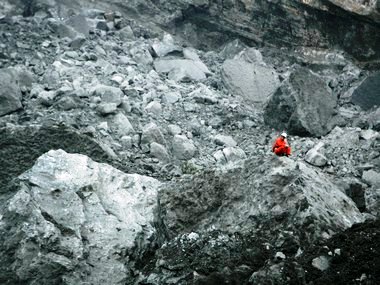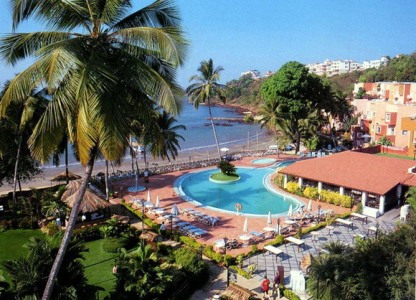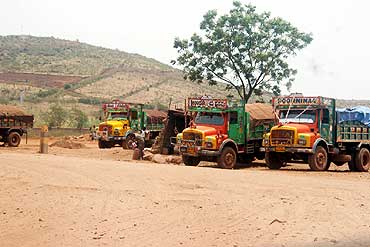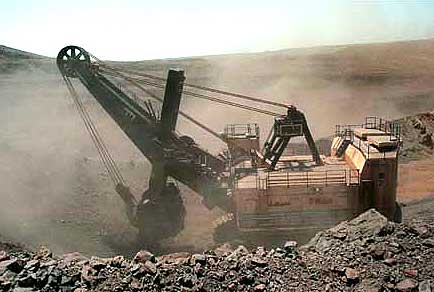
The mining crisis in Goa, the country's largest exporter and second-largest producer of iron ore, is set to worsen.
With the probe of the Centre-appointed Shah commission into alleged irregularities entering its last lap, Goan miners have started bracing themselves for a possible Karnataka-like blanket ban on mining and exports.
The ban in Karnataka had been imposed by the Supreme Court in July in response to a Central Empowered Committee report that alleged large-scale illegal mining and violations of environmental norms.
. . .

The Shah commission, appointed in November last year, will give its report to the Centre.
India mines around 220 million tonnes of iron ore annually.
Karnataka, which accounts for a fifth of it, exported nearly half of its 42 mt production before the ban. Goa produces 35 mt, but exports nearly 55 mt -- the rest 20 mt coming from low-grade dumps.
The state government had recently banned the export of dumps over allegations of illegal mining.
Though a blanket ban on iron ore exports seems unlikely in Goa, with the mines ministry not likely to favour the move, miners fear the worst.
. . .

Goa accounts for more than half of India's annual iron ore exports of 100 mt -- worth Rs 28,300 crore (Rs 283 billion).
Also, Goan miners cannot switch supplies to steel mills located within the country, as there are no takers for the naturally inferior-grade Goan ore.
"A ban on exports would act as a death knell for us. But we cannot do anything but wait for the final Shah commission report," P K Mukherjee, managing director of Sesa Goa, India's largest private sector iron ore producer, told Business Standard.
Three-fourths of Sesa Goa's iron ore production capacity of 22 mt in India comes from Goa.
. . .

"We will shut operations in the event of a ban. In any case, there is no debt on our books," Ambar Timblo, managing director of Goa's second-largest producer, Fomento Resources, said.
"According to our analysis, our earnings this financial year will drop by at least 35 per cent from those last year," he added.
Last financial year, the company exported 12 mt iron ore, worth around Rs 2,400 crore (Rs 24 billion).
"Our business will become zero and the whole company will come to a standstill if a ban is imposed. It is a crisis for sure," said Shivanand Salgaonkar, managing director of V M Salgaonkar & Bro Pvt Ltd, Goa's third-largest and oldest miner.
. . .

The company produced and exported 5 mt iron ore last year.
The Shah commission had no deadline for giving its final report, a senior official from the mines ministry said.
"The mines ministry does not favour a blanket ban on exports to curb illegal mining," he added, indicating the concern of Goan miners might be misplaced.
Even in Karnataka, the CEC recently gave a breather to 24 mines by recommending their reopening.
Meanwhile, in Goa, a host of issues hinting at irregularities in mining operations are being pointed out by authorities.
. . .

DUMPS
Dumps are the low-grade by-product of the iron ore mining process.
Goan ore has an average iron content of 55 per cent, compared to the national average of over 62 per cent.
Dumps produced in the mines of the region have less than 45 per cent of iron content.
As dumps had no commercial value, Goan miners traditionally allowed these stocks to pile up beside lease areas.
Accumulated over many decades, these have now swelled to a massive 700 mt -- its value running into thousands of crores of rupees.
In response to a huge spurt in global iron ore prices in the past 3-4 years, primarily driven by China's exponentially increasing demand for low-grade ore, the Indian government, in late 2009, brought down the threshold of Fe (iron) content for 'commercially sellable' iron ore from 55 Fe to 42 Fe.
. . .

The move made Goan dumps, which had so far been waste, commercially valuable. This kicked off a race for their exports.
The current crisis in the state stems largely from the allegation that Goan miners are illegally exporting iron ore in the name of moving dumps.
What stokes this suspicion is the mismatch, although small, between the quantity of ore for which royalty is paid to the state government and the quantity exported every year.
Also, dumps have traditionally been placed outside lease areas of almost all mines in Goa.
While the Shah Commission is said to have objected to the practice, calling it violation of lease area, miners argue that the practice is in line with their mining plans, approved by the Indian Bureau of Mines.
The government had, in 1988, converted all the erstwhile mining concessions in Goa into mining leases, valid for 20 years, in the interest of mineral conservation.
As a result, all the 336 leases in the state together came up for renewal in 2008.
As grant of renewal by the state government was delayed in most of the cases, the lease periods of all mines were deemed to be extended, in line with the Mineral Conservation and Development Rules, subject to environment clearances.
. . .

Deemed extension
The Shah Commission has allegedly brought all such mines under the irregularity net, as ECs for most of these mines have not been obtained.
A major reason for the delay is the extremely under-staffed state mining department.
"The situation has become complex.
"With strength of a mere 50, we are expected to handle all the cases for renewals. Delays are bound to take place," said a senior state mining department official, who did not wish to be quoted.
Besides hurting miners' revenue and India's mineral export earnings, an export ban, if imposed, would also leave thousands of mine workers and truck and barge operators jobless.
The reduced cost of transporting ore from mines to jetties for exports through barges, compared to transport through road, has kept iron ore exports in the region remunerative for several years.